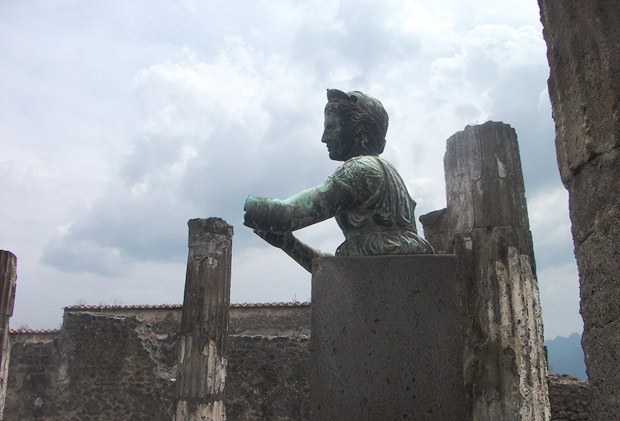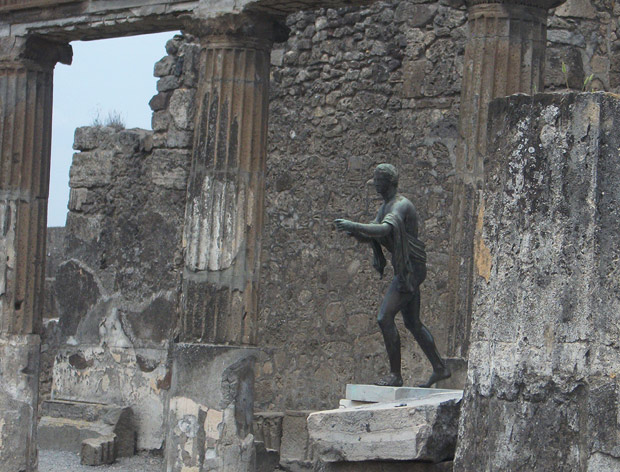The two bronze statues at the heart of the current Getty Villa exhibition Apollo from Pompeii: Investigating an Ancient Bronze—set to close September 12—may look rather familiar if you’ve traveled to Pompeii or seen it in pictures. For as you enter the ruins of the Temple of Apollo at Pompeii, you are met by Apollo and Diana, who stand facing one another on pedestals.
These statues are replicas of the originals currently on loan at the Villa. They were produced by the Fonderia Chiurazzi in Naples and set up in the early twentieth century.


Chiurazzi replicas of Roman bronze sculptures of Diana (above) and Apollo (below) at the Temple of Apollo at Pompeii.
From the 1860s, the National Archaeological Museum at Naples began granting permits for the official production of copies of their extraordinary collection of sculptures, which included the finds from Pompeii and Herculaneum. In the late nineteenth century, a variety of firms in Naples saw the opportunity to capitalize on the flourishing interest in the Vesuvian sites, and produced replicas alongside photographs and other mementos for travellers.
Museums, educational institutions, private individuals and even hotels were eager buyers of such replicas during the 19th and 20th centuries, commissioning them as valuable teaching tools or as substitutes for the originals they could never own.
Fonderia Chiurazzi, established in 1870, was one of the leading makers of replicas. The foundry quickly assembled one of the richest collections of moulds, which to this day remains a valuable historical record, and for many years had a shop in the arcade opposite the National Archaeological Museum in Naples. Their 1929 catalogue included reproductions of statues, armour, mosaics and vessels from the Naples Museum, as well as of famous sculptures from other renowned European museums.
The bronze replicas were available in up to three sizes, and also three finishes: Herculaneum (dark); Pompeii (greenish), and Rinascimento (gleaming bronze).
Chiurazzi replicas can be found all over the world, from the Laocoön that greets visitors at the Museo metro stop in Naples to a statue of the Cacique at Maracay, Venezuela, but the foundry has a particular significance for the Getty. In the 1970s the Chiurazzi received a substantial commission from the architects working for J. Paul Getty during the construction of the Villa. For in creating a museum based on the design of the Villa dei Papiri in Herculaneum, it was logical to include replicas of the famous statues that were found there during the excavations in the mid 18th century. (The Herculaneum finish is the one you see at the Villa, naturally.)
The company name is inscribed on some of the sculptures at the Villa, and you can see it if you look closely. Here’s one on the delicate backside of Hermes, the messenger god who sits watch over the reflecting pool in the Outer Peristyle.

Detail of Chiurazzi stamp on the bronze statue of Hermes in the Outer Peristyle
To coincide with Apollo from Pompeii: Investigating an Ancient Bronze, a team of scholars visited the museum to discuss the restoration of ancient bronzes in the nineteenth century. Among them were Carol Mattusch, Mathy Professor of Art History at George Mason University and author of The Villa dei Papiri at Herculaneum. We spoke to her about the placement of Chiurazzi bronzes at the Getty Villa—and about their most striking feature, their eyes.
Luisa Fucito, archivist of the Chiurazzi Foundry, also visited and shared valuable information about the history of the firm and her father’s involvement with the creation of these bronzes. (See her reaction to seeing the bronzes at the Villa for the first time in the video at the top of this post.)
The Chiurazzi replicas at the Villa remain on view today. They provide a wonderful opportunity for our visitors to see these statues as a wealthy Roman would—as a collection of figures interacting visually with one another, evoking reminiscences and comparisons, and enlivening the Villa’s gardens.
Videos by Steve Saldivar




I have a signed statue of mercury by Chiurazzi. It is signed Chiurazzi d Napoli
I would like to know more about it.
Hello, I do hope you can help me. I am looking for the replica from Chiurazzi of the Astragalus girl.
It used to be available before the Chiurazzi firm of Naples was taken over. Now I am lost on internet to find this lovely sculpture. Any idea where and how I can have/order a copy?
Best regards,
mrs. Tonny Michels